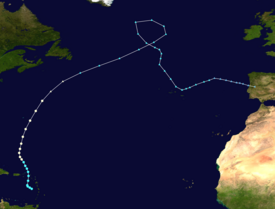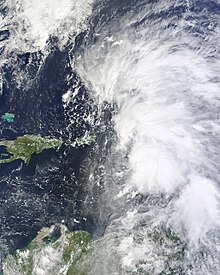Hurricane Rafael
United States East Coast, Azores, Western Europe | |
| IBTrACS | |
Part of the 2012 Atlantic hurricane season |
Hurricane Rafael produced minor damage in the northeastern
As a disorganized tropical cyclone in the northeastern Caribbean, Rafael produced major flooding across the region. As much as a foot of rain fell across portions of the Lesser Antilles, causing mudslides, landslides, and river flooding. In addition, the heavy rains led to significant crop loss. Sustained winds near hurricane force were recorded on Saint Martin, while tropical storm-force gusts occurred widespread. Lightning activity as a result of heavy thunderstorms caused many fires and power outages. One fatality occurred when a woman in Guadeloupe unsuccessfully attempted to drive her car across a flooded roadway. As Rafael passed just to the east of Bermuda as a hurricane, light rainfall was recorded. Gusts over 50 mph (85 km/h) left hundreds of houses without electricity. Large swells from the system caused significant damage to the coastline of Nova Scotia, while many roads were washed away or obscured with debris, but overall, damage was minimal.
Meteorological history

Tropical storm (39–73 mph, 63–118 km/h)
Category 1 (74–95 mph, 119–153 km/h)
Category 2 (96–110 mph, 154–177 km/h)
Category 3 (111–129 mph, 178–208 km/h)
Category 4 (130–156 mph, 209–251 km/h)
Category 5 (≥157 mph, ≥252 km/h)
Unknown
The formation of Hurricane Rafael is attributed to a low-latitude
Despite being named, Rafael remained disorganized initially;[6] this was the result of the interaction between an upper-level trough and the cyclone itself. Moderate to strong wind shear dislocated the center of Rafael and the deepest shower and thunderstorm activity.[7] Over the course of the next few days, however, the upper-level trough gradually weakened and backed westward, allowing for the development of an anticyclone atop the tropical storm. Wind shear lessened, allowing the center to become obscured from view and outflow to develop in association with the system. As it began to execute a turn towards the north under the influence of an upper-level trough to its west, a central dense overcast (CDO) was noted on satellite imagery.[8] Following a series of intensity estimates, Rafael was upgraded to a hurricane around 0600 UTC on October 15, while positioned about 650 mi (1045 km) south of Bermuda, although this intensity was speculated upon until later that afternoon following a hurricane hunters flight into the system.[5]

As Rafael moved northward, it continued to intensify
Preparations and impact
Caribbean islands

Shortly after the development of Rafael, a
As a tropical storm, Rafael hit
Bermuda
As Rafael exited the northeastern Caribbean Sea, a tropical storm watch was issued for Bermuda on October 14. This watch was subsequently upgraded to a tropical storm warning the following morning, but was dropped by early on October 17 as the system passed northeast of the island.[5] In advance of the system, residents were urged to take their typical precautionary measures;[15] in addition, the main two airlines on Bermuda—WestJet and United Airlines—cancelled hundreds of flights on October 16.[16] Officials warned of minor storm surge along low-lying coasts,[17] while the Bermuda Weather Service (BWS) warned of two to four inches of rainfall. Winds, while stronger than locals expected, did not cause significant damage.[18] The BWS noted that sustained winds of 34 mph (55 km/h), and gusts reaching 51 mph (82 km/h), occurred at the L.F. Wade International Airport as the storm made its closest approach;[19] these winds left about 600 houses without electricity according to the Bermuda Electric Light Company.[18] Rainfall was less than originally feared, peaking at 1.71 inches (43 mm).[19]
Newfoundland
Though tropical cyclone watches and warnings were not issued, city officials in St. John's recommended all residents in Newfoundland to prepare for Rafael.
See also
- List of Bermuda hurricanes
- 2012 Atlantic hurricane season
- Hurricane Otto (2010)
- Hurricane Jose (1999)
References
- ^ Robbie Berg (October 8, 2012). "Graphical Tropical Weather Outlook". National Hurricane Center. National Oceanic and Atmospheric Administration. Retrieved January 19, 2013.
- ^ John Cangialosi (October 10, 2012). "Graphical Tropical Weather Outlook". National Hurricane Center. National Oceanic and Atmospheric Administration. Retrieved January 19, 2013.
- ^ Stacy Stewart (October 11, 2012). "Graphical Tropical Weather Outlook". National Hurricane Center. National Oceanic and Atmospheric Administration. Retrieved January 19, 2013.
- ^ Michael Brennan (October 12, 2012). "Graphical Tropical Weather Outlook". National Hurricane Center. National Oceanic and Atmospheric Administration. Retrieved January 19, 2013.
- ^ a b c d e Lixion Avila (January 14, 2013). Hurricane Rafael Tropical Cyclone Report (PDF). National Hurricane Center (Report). National Oceanic and Atmospheric Administration. Retrieved January 19, 2013.
- ^ Jack Beven (October 12, 2012). Tropical Storm Rafael Discussion Number 2. National Hurricane Center (Report). National Oceanic and Atmospheric Administration. Retrieved January 19, 2013.
- ^ Todd Kimberlain; Lixion Avila (October 13, 2012). Tropical Storm Rafael Discussion Number 3. National Hurricane Center (Report). National Oceanic and Atmospheric Administration. Retrieved January 19, 2013.
- ^ Stacy Stewart (October 15, 2012). Tropical Storm Rafael Discussion Number 11. National Hurricane Center (Report). National Oceanic and Atmospheric Administration. Retrieved January 19, 2013.
- ^ Fiona Stokes (October 15, 2012). "Tropical Storm Rafael passes V.I. without bringing much rain". Virgin Islands daily news. Archived from the original on April 12, 2013. Retrieved March 9, 2013.
- Le Nouvel Observateur(in French). October 14, 2012. Retrieved October 18, 2012.
- ^ "Le sud Basse-Terre très touché par la tempête Rafaël". France-Antilles (in French). October 14, 2012. Retrieved October 17, 2012.
- ^ a b LK Hewlett (October 19, 2012). "SKN Recovering from Effects of TS Rafael". St. Kitts & Nevis Observer. Archived from the original on March 3, 2016. Retrieved October 19, 2012.
- ^ Drizel Hanley (October 19, 2012). "Tropical Storm Rafael dumps rain in St. Kitts". The Labor Spokesman. Archived from the original on March 5, 2016. Retrieved October 19, 2012.
- ^ National Hurricane Center (October 17, 2012). "Preliminary Storm Local Report". National Weather Service. Retrieved October 17, 2012.
- ^ Ceola Wilson (October 16, 2012). "'Business as usual' for Island as Hurricane Rafael nears". The Royal Gazette. Retrieved March 8, 2013.
- ^ Staff writer (October 16, 2012). "Flight Cancellations Start: BA, Westjet, United". Bernews. Retrieved March 8, 2013.
- ^ Eric Blake (October 16, 2013). "Hurricane Rafarl Public Advisory Number 17". National Hurricane Center. Retrieved March 8, 2013.
- ^ a b "Hurricane Rafael leaves Bermuda behind". CNN. October 16, 2012. Archived from the original on April 10, 2013. Retrieved October 18, 2012.
- ^ a b Jeff Masters (October 17, 2012). "Paul pulls its punch before hitting Baja; Rafael brushes Bermuda". Weather Underground. Archived from the original on September 6, 2015. Retrieved October 18, 2012.
- ^ Staff writers. "Storm surge possible as post-tropical storm Rafael passes Newfoundland's Avalon Peninsula". The Weather Network. Archived from the original on October 20, 2012. Retrieved March 8, 2013.
- ^ a b "Newfoundland town hit by Rafael damage". CBC News. October 19, 2012. Archived from the original on October 20, 2012. Retrieved October 19, 2012.
- ^ Deana Sullivan (October 18, 2012). "Rafael stirs up surf in Trepassey". The Telegram. Archived from the original on February 6, 2013. Retrieved October 12, 2012.
- ^ Staff writer (October 18, 2012). "Rafael storm surge causes wave damage". Metro News. Archived from the original on January 2, 2014. Retrieved March 8, 2013.
- ^ "Post-tropical storm Rafael blew past Newfoundland but whipped up wild waves". Edmonton Journal. October 18, 2012. Archived from the original on May 22, 2024. Retrieved October 19, 2012.
External links
 Media related to Hurricane Rafael (2012) at Wikimedia Commons
Media related to Hurricane Rafael (2012) at Wikimedia Commons

